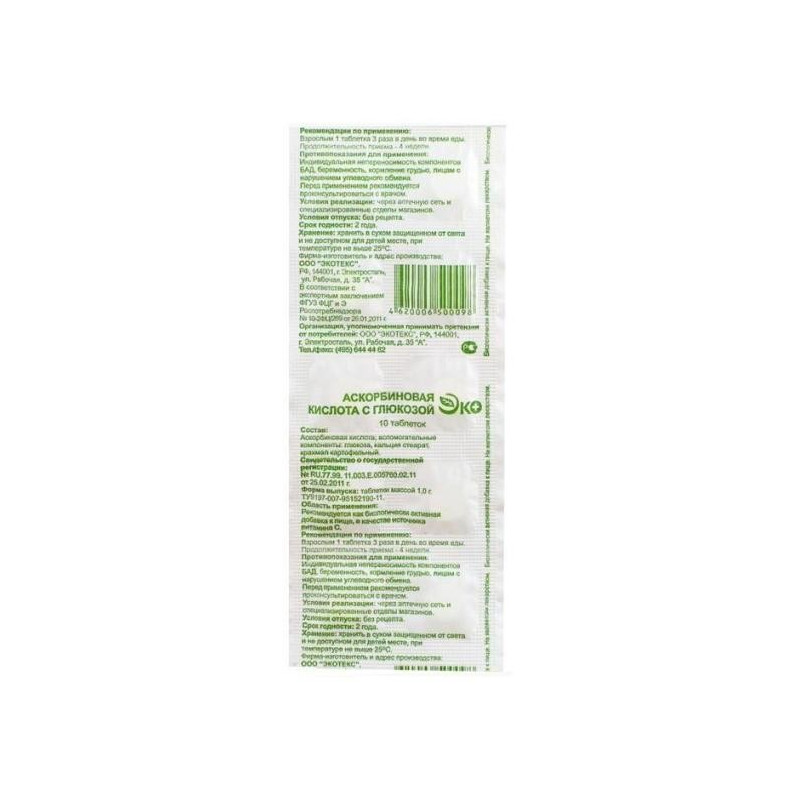



 All payments are encrypted via SSL
All payments are encrypted via SSL
 Full Refund if you haven't received your order
Full Refund if you haven't received your order
Ascorbic acid plays an important role in the regulation of redox processes, carbohydrate metabolism, blood clotting, tissue regeneration, contributes to an increase in body resistance. Ascorbic acid (vitamin C) is not formed in the human body, and comes only with food. With a balanced and nutritious diet, a person is not deficient in vitamin C.
Dextrose is involved in various metabolic processes in the body, enhances the redox processes in the body, improves the antitoxic function of the liver. Absorbed completely by the body, the kidneys are not excreted (appearance in the urine is a pathological sign).
Ensuring the increased need of the body for vitamin C in the period of intensive growth, pregnancy, breastfeeding, with increased physical and mental stress, stressful conditions, in the period of recovery after long and serious diseases.
The drug is taken orally after meals.
For prophylactic purposes, prescribe:
- adults 50-100 mg / day;
- for children from 6 to 14 years old - 50 mg / day, from 14 to 18 years old - 75mg / day;
- during pregnancy and lactation at 300 mg / day for 10-15 days, then at 100 mg / day.
With the purpose of treatment prescribed:
- for adults 50-100 mg / day 3-5 times a day;
- children 50-100 mg 2-3 times a day.
The maximum daily dose for adults is 1000 mg, for children - 500 mg.
The duration of treatment depends on the nature and course of the disease and is recommended by a doctor.
Allergic reactions to the components of the drug, irritation of the mucous membrane of the gastrointestinal tract (nausea, vomiting, diarrhea, spasm of the gastrointestinal tract) are possible; inhibition of the function of the insular apparatus of the pancreas (hyperglycemia, glycosuria); when used in high doses, hyperoxaluria and nephrocalcinosis (oxalate). Changes in laboratory parameters: thrombocytosis, hyperprothrombinemia, erythropenia, neutrophilic leukocytosis, hypokalemia.
Hypersensitivity to the drug. You should not assign large doses of patients with increased blood clotting, thrombophlebitis and a tendency to thrombosis, as well as diabetes and conditions accompanied by high blood sugar. Children's age up to 6 years.
Carefully: Deficiency of glucose-6-phosphate dehydrogenase; when used in large doses, hemochromatosis, sideroblastic anemia, thalassemia, hyperoxaluria, nephurolythiasis.
The use is possible according to the dosing regimen.
With caution in hyperoxaluria, nephroluritiasis. In connection with the stimulating effect of ascorbic acid on the formation of corticosteroid hormones, it is necessary to monitor the function of the kidneys.
Contraindicated in children under 6 years. Children over 6 years old may use according to the dosing regimen.
In connection with the stimulating effect of ascorbic acid on the formation of corticosteroid hormones, it is necessary to monitor renal function and blood pressure.
With long-term use of large doses, the function of the insular apparatus of the pancreas may be inhibited, therefore during treatment it must be regularly monitored.
In patients with a high content of iron in the body, ascorbic acid should be used in minimal doses.
The administration of ascorbic acid to patients with rapidly proliferating and intensely metastatic tumors can aggravate the process.
Ascorbic acid as a reducing agent can distort the results of various laboratory tests (blood glucose, bilirubin, activity of “liver” transaminases and lactate dehydrogenase).
Patients with diabetes should consider that in 1 pill contains about 0.08 XE, in a daily dose (5 tablets) - contains about 0.4 XE.
Influence on ability to drive vehicles and mechanisms. No data available.
Symptoms: when using more than 1 g - headache, increased excitability of the central nervous system, insomnia, nausea, vomiting, diarrhea, hyperacid gastritis, ulceration of the mucous membrane of the gastrointestinal tract, inhibition of the function of the insular apparatus of the pancreas (hyperglycemia, glycosuria), hyperoxaluria, nephrolithiasis ( from Calcium oxalate), damage to the glomerular apparatus of the kidneys, moderate pollakiuria (when taking a dose of more than 600 mg / day). Reduced capillary permeability (possibly worsening of tissue trophism, increased blood pressure, hypercoagulation, the development of microangiopathies).
Ascorbic acid increases the concentration in the blood of benzylpenicillin and Tetracycline.
Improves absorption of iron preparations.
Slows kidney excretion of acids, increases the excretion of drugs having an alkaline reaction (including alkaloids).
Increases the overall clearance of ethanol, which in turn reduces the concentration of ascorbic acid in the body.
Drugs quinoline series, calcium chloride, glucocorticosteroids with prolonged use deplete ascorbic acid reserves.
With simultaneous use reduces the chronotropic effect of isoprenaline.
With prolonged use or use in high doses may disrupt the interaction of disulfiram-ethanol.
In high doses, increases the excretion of meksiletina kidneys.Barbiturates and primidone increase the excretion of ascorbic acid in the urine. Reduces the therapeutic effect of antipsychotic drugs (neuroleptics) - phenothiazine derivatives, tubular reabsorption of amphetamine and tricyclic antidepressants.
In a dry dark place at a temperature not higher than 25 ° C. In the reach of children.
Shelf life. 2 years. Do not use after the expiration date.
